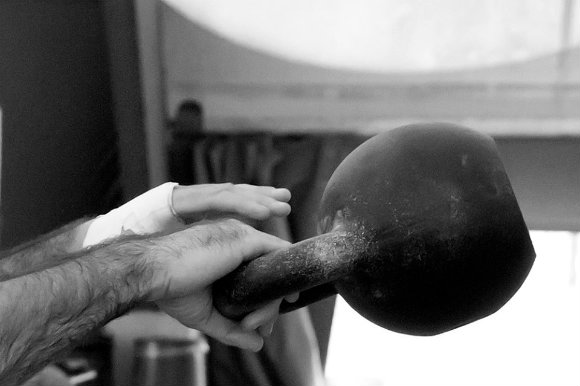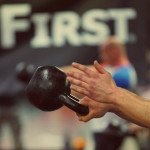Adding one-hand kettlebell swings to your Simple & Sinister training can be daunting for some people. Some of the symptoms include:
- Grip – you feel like the bell is going to fly out of your hand.
- Posture – you feel unable to maintain a forward-facing torso when the weight is in one hand.
First things first – there is no magic solution to your problem. You aren’t strong enough yet at one-hand swings. But since you feel more than able to complete the number of two-hand swings the program gives, you need a way over this particular hump.
Performing your single-hand swings with a lighter weight is one option – and a good option, but not necessary for most people if you have first reached the program’s requirement by using only two-hand swings. Instead, try the approach I’ve outlined below – and finally let go of that extra hand.

How to Read This Swing Program
Within a single set of 10 repetitions, mix two- and one-hand swings. I credit Master SFG Brett Jones with introducing this concept to me.
Here is your first set of 10 reps – shorthand explained in a moment:
- 2T + 2L + 2T + 2R + 2T
That’s 2 two-hand, 2 left hand only, 2 two-hand, 2 right hand only, and 2 two-hand to finish.
Note: I drove five hours and paid for a hotel in order to attend a four-hour workshop by Mr. Jones, and then arranged for him to work with me one-on-one afterward before I got back into my car for the five hour drive home. If you need in-person instruction, make no excuses – look up an SFG in your area and arrange a training session or get yourself to the nearest SFG if none are nearby.
Why You Will Mix Two- and One-Hand Swings
The reason you will mix single-arm and double-arm swings in a single set is to allow your two-hand swing to “teach” your one-hand swing. Feel the amount of explosiveness in your two-hand swing; note the “float” you achieve at the top of each rep; acquire a feeling for how long you wait before moving your hips out of the way of the descending bell, and for quickly you change the bell’s direction at the backmost place in the swing – and now try to duplicate these things in your one-arm swing.
It goes without saying that most people will find one side works better than the other, so also allow your strong side to learn from your stronger side. Note: we don’t have a “weak” side at StrongFirst, only a strong side and a stronger side. Thank you, Master SFG David Whitley, for that perspective.
Why two reps? A single rep each side isn’t going to be enough to let you get a feel for how you’re doing with your one-arm swing on that side – but two will suffice.
How to Follow This Kettlebell Swing Program
Perform as many of your sets of 10 in the above format as you feel appropriate for your current level of prowess at the one-arm swing. If you are doing 5 sets of 10, try it for your second set before returning to two hands for the remainder.
You do not need to wait until you are doing 10 sets of 10 two-hand swings before introducing the one-armed swing to your training. Try a little, see what you think, continue to perform one-arm swings if your good judgment says this is an option for you.
A Sample Progression
One way to increase the intensity of your swing workout – and therefore to make progress – is to keep the rep count and set count the same but increase the number of one-hand swings. You might progress like this – each line represents a single day’s swing workout.
- 50: 10T x 5 (10 two-hand swings x 5 sets)
- 50: 10T x 1, 2T+2L+2T+2R+2T x 1, 10T x 3 – one set, 4 one-arm swings
- 50: 10T x 1, 2T+2L+2T+2R+2T x 2, 10T x 2 – two sets, 8 one-arm swings
- 50: 10T x 1, 2T+2L+2T+2R+2T x 3, 10T x 1 – three sets, 12 one-arm swings
Then, at your next workout:
- 70: 10T x 7
In the last workout above, you have temporarily abandoned the one-arm swing as you perform a greater total volume. When you feel ready, you may then start adding one-hand swings back into your 70-total swing workout, and so on.
Workout Math
At some point along the way, you may feel confident enough in your one-arm swing to want to do more than two a time. Bravo! Make it so! You need to be able to count to ten, and add a string of numbers that equals ten, in order to do this. If that’s a problem for you, spend some time working on arithmetic, please.
- 2T + 3L + 2T + 3R = 10 reps
The above yields 6 single-arm swings out of 10 instead of the previous total of 4 single-arm swings. A 50% increase per set – nice!
A further increase would be:
- 1T + 4L + 1T + 4R = 10 reps
We’re now at 8 single arms swings out of 10 – you’re almost there, and moving to all one-arm swings is sure to be in your near future.
Mix and Match
Note that all these intermediate formats can be mixed. Below is a single workout, with each set on a separate line for clarity. 50 reps, pyramiding the number of one-arm swings
- 10T x 1
- 2T + 2L +2T +2R + 2T
- 2T + 3L + 2T + 3R
- 2T + 2L +2T +2R + 2T
- 10T
You’ll have finished 50 swings with 14 single-handed.
Conclusion
Feel free to switch left and right hands in everything above – find which order works best for you, or switch between them if both sides are fairly equal and you can keep track.
The instant feedback you receive when switching between two- and one-hand swings can be an extremely valuable tool in your quest for the ultimate explosive expression of the final Simple, and eventually the final Sinister workout in Pavel’s Kettlebell Simple & Sinister. Pay attention to your form on every rep, and use what you can already do well to help you improve the movement patterns at which you aren’t as strong.
I hope this helps you achieve your goal – please drop a note on the StrongFirst discussion forum to tell me of your progress.
Dr. Steve Freides
GET YOUR COPY OF SIMPLE & SINISTER HERE





Excellent article, thanks very much Steve ! I’ve tried adding sets of 10 one-handed swings to my routine previously , but an old elbow tendonitus injury has always flared up. This looks a much safer way of trying to progress !
Great article for us newbies who haven’t even heard of kettlebells or RKC back in 2002.
Very useful article. I tried to add sets of ten of one handed swings with limited success as my technique deteriorated by the end of each set. The here presented approach seems much more sensible. Thanks.
Great, thanks.
Dr. Freides, what do you suggest for patients that have grip limitations such as arthritis?
Craig, I don’t know. A person should clear any exercise program with their doctor before beginning. The purpose of the article is to assist people who are already, with doctor’s approval, following Kettlebell Simple & Sinister. That wouldn’t include someone whose arthritis prevented them from following the program.
Please also note that, as I mentioned earlier today on the forum, I am often called Doctor or Professor because I hold a doctoral degree in music. I come from academia where honorifics such as Doctor or Professor are often required of students, e.g., at my wife’s middle school where I teach part-time, the students are required to address me as Doctor Freides. When I taught college, it was Professor instead. I apologize if the term “doctor” caused any confusion.
When changing from two hands to one, or from one hand to the other, do you put the bell down or do you use hand to hand swings?
Switch when the bell is in front of you, e.g., if you are switching from two hands to one, finish the two-hand swing by bringing the bell in front of you with two hands. Then, as the bell is momentarily motionless in front of you, switch to a one hand grip and swing the bell back with one hand.
Great article, Steve and even better timing. I was just wondering how to incorporate one hand swings and this really helps.